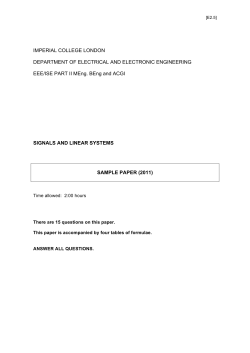
2141005 - Gujarat Technological University
GUJARAT TECHNOLOGICAL UNIVERSITY ELECTRONICS (10), ELECTRONICS & COMMUNICATION (11), ELECTRONICS & TELECOMMUNICATION ENGINEERING (12) SIGNALS AND SYSTEMS SUBJECT CODE: 2141005 B.E. 4th SEMESTER Type of Course: Foundation of signals and systems for electrical, electronics and electronics and communication engineering Prerequisite: Inclination to learn mathematics, basic knowledge of differential equations and difference equations, electrical circuits and networks. Rationale: The course will provide strong foundation on signals and systems which will be useful for creating foundation of communication and signal processing. The students will learn basic continuous time and discrete time signals and systems. Student will understand application of various transforms for analysis of signals and systems both continuous time and discrete time. Students will also explores to power and energy signals and spectrum. Teaching and Examination Scheme: Teaching Scheme Credits L T P C 3 0 2 5 Examination Marks Theory Marks Practical Marks ESE PA (M) ESE (V) PA (E) (I) PA ALA ESE OEP 70 20 10 20 10 20 Content: Sr. Topics No. Basic definitions, Classification of signals and systems. Signal operations and properties. Basic continuous time signals, signal sampling and quantization, discretization of continuous time signals, 1 discrete time signals. Basic system properties, Representation of digital signals. Case study of different signals form communication and biomedical field Impulse response characterization and convolution integral for CT- LTI system, signal responses to CT-LTI system, properties of convolution, 2 LTI system response properties from impulse response. (*Review of Laplace transform with reference to CT signals and systems.) Impulse response characterization and convolution sum, Causal signal response to DT-LTI systems. Properties of convolution summation, 3 Impulse response of DT-LTI system. DT-LTI system properties from Impulse response. System analysis from difference equation model Representation of periodic functions, Fourier series, Frequency spectrum of aperiodic signals, Fourier Transform, Relation between 4 Laplace Transform and Fourier Transform and its properties. Introduction to DTFT and DFT The z-Transform, Convergence of z-Transform, Basic z-Transform, Properties of z-Transform, Inverse z-Transform and Solving difference 5 equation using z-Transform Total Marks 150 Teaching Hrs. 7 Module Weightage 15 7 15 9 30 8 25 7 15 *This has been covered in circuits and networks in third semester as well as required in control system engineering course. Thus, quick review is recommended. Suggested Specification table with Marks (Theory): Distribution of Theory Marks R Level 7 U Level 21 A Level 14 N Level 21 E Level 7 Legends: R: Remembrance; U: Understanding; A: Application, N: Analyze and E: Evaluate and above Levels (Revised Bloom’s Taxonomy) Note: This specification table shall be treated as a general guideline for students and teachers. The actual distribution of marks in the question paper may vary slightly from above table. Reference Books: 1. 2. 3. 4. 5. 6. Signals and Systems by Alan V. Oppenheim, Alan S. Wilsky and Nawab, Prentice Hall Signals and Systems by K. Gopalan, Cengage Learning (India Edition) Signals and Systems by Michal J. Roberts and Govind Sharma, Tata Mc-Graw Hill Publications Signals and Systems by Simon Haykin and Bary Van Veen, Wiley- India Publications Linear Systems and Signals by B.P.Lathi, Oxford University Press Signal, Systems and Transforms by Charles L. Philips, J. M. Parr and E. A. Riskin, Pearson Education 7. Digital Signal Processing Fundamentals and Applications by Li Tan, Elsevier, Academic Press 8. Signal and Systems By Anand Kumar, 3rd Edition, PHI Course Outcomes: After learning the course the students should be able to: Understand about various types of signals, classify them, analyze them, and perform various operations on them. Understand about various types of systems, classify them, analyze them and understand their response behavior. Appreciate use of transforms in analysis of signals and system. Carry simulation on signals and systems for observing effects of applying various properties and operations. Create strong foundation of communication and signal processing to be studied in the subsequent semester List of Experiments: 1. Generations and capturing various continuous time signals from sensors. 2. Generation and capturing of discrete time signals and plot them. 3. Discretization using different sampling rate and observing aliasing effect. 4. Observing the effects of lower sampling rate and higher sampling rate on CT signal. 5. Performing various operations on the signal using circuits and computational software. 6. Using digital circuit building block to perform operations on signals. 7. Simulation of continuous time LTI system. 8. Simulation of discrete time LTI systems. 9. Obtaining impulse response of the systems. 10. Computing FT and DTFT of the CT signals and DT sequences. Design based Problems (DP)/Open Ended Problem: 1. Design of active noise removal / cancellation circuit. 2. Design of digital building blocks to perform various operations on discrete time sequences and singals. 3. Design of efficient and accurate signal converter. 4. Design of sample and hold circuits 5. Design of anti aliasing filter, Major Equipments: Computers, analog circuit blocks, digital circuit blocks, signal generators, digital storage oscilloscope and spectrum analyser List of Open Source Software/learning website: SEQUEL SCILAB NPTEL Videos MIT open course ware website ACTIVE LEARNING ASSIGNMENTS: Preparation of power-point slides, which include videos, animations, pictures, graphics for better understanding theory and practical work – The faculty will allocate chapters/ parts of chapters to groups of students so that the entire syllabus to be covered. The power-point slides should be put up on the web-site of the College/ Institute, along with the names of the students of the group, the name of the faculty, Department and College on the first slide. The best three works should submit to GTU.
© Copyright 2025





















